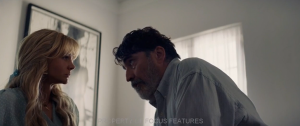103 Promising Young Woman (2020)
An Alternative to Internalized Patriarchy: Promising Young Woman (2020)
By Nicole Potekev
Hollywood is no stranger to the Assault & Avenger genre. Yet, Promising Young Woman (2020), is perhaps the first movie directed by a woman to hit theaters in a post #MeToo Movement America and upturn the familiar, fictional formula. Promising Young Woman stars Carey Mulligan as Cassandra, a med-school drop-out bent on revenge for her friend Nina, who was assaulted by a promising, young Alexander Monroe. In the first act, Cassandra aims her ire at middle-class ‘nice guys’ in bars, feigning drunkenness to lure in these would-be saviors, until chillingly revealing her sobriety after they attempt to do more than help. In the second act, Cassandra shifts her attention to systematic retribution against, 1) Nina’s disbelieving female peer, 2) the college’s female Dean, 3) the lawyer who defended Al Monroe, and 4) Al Monroe himself. Through Cassandra’s moral greyness, and cinematic decisions unique to its sub-genre, this Comedy-Thriller paints an entertaining and disquieting alternative to our internalized narratives on assault, race, gender, and culpability.
Carrie Mulligan as Cassandra
At the larger-scale genre, slasher movies have historically targeted and greenlighted violence against women. Sure, both genders have a terrible time in horror movies, but “men are usually killed quickly offscreen or in shadows, while women are killed in full view, often in extended sequences of suspense and torture” (Benshoff and Griffin 338). This is highly intentional. After the creation of the Movie Rating System in 1968, “The new Ratings System allowed not only greater amounts of gratuitous sex but greater amounts of gratuitous violence to be seen on movie screens… Disturbingly, some films of the era feature very graphic visualizations of sexualized violence, including rape” (Benshoff and Griffin, 329-330). Notorious films such as I Spit on Your Grave (1978, 2010), Death Wish (1974), Sudden Impact (1978), and many others of their kind tell the same story. First, the inciting incident. They horrendously display graphic violence, against women, via urban crime. Then the victim goes on a murderous rampage against their assaulter(s). Or, if the plot often prefers, a woman is so badly injured or simply killed, that they conveniently cast a boyfriend or father-figure to lead as the male protagonist. While the sentiment is superficially avenging women, the cinematic design, perspective, shot length, and focus on violence, do more to sensationalize and sexualize such crimes. A 2012 study of 48 influential slasher films from the 1960s to 2010s found that “Sexually active women are punished while the films simultaneously sexualize their deaths and the torturous escapes of female heroines” (Wellman). These messages don’t go unnoticed. When movies encode the message that sexual women deserve crimes against them, that crimes occur on unprotected streets, that rapists are unrelatable inhuman caricatures of evil, that justice is clear…audiences decode and internalize these stories. A formula so repetitive becomes its own cultural mythos, a mythos which Promising Young Woman deconstructs.
From the very beginning of Promising Young Woman, writer/director Emerald Fennell strategically reframes the composition of tropes. Cassandra isn’t a male protagonist. She isn’t avenging her own trauma, but her oldest friend, Nina. Despite my previous synopsis, we seldom, only briefly, see sexual acts. Violence is occasional, but never sexualized. While Cassandra may smash car windows, poach men, and… well…maybe someone dies…they are separate events. Violence is never conflated with sex appeal. Most notably, we never see a frame of Nina’s assault. Nina doesn’t even appear in the cast. No appearance on-screen means no woman is associated with victimhood. Unlike every narrative with the same premise一which exploit the inciting incident to create a murky sexual slasher film一this director opts for an edge-of-your-seat suspense thriller. It’s actually a powerful move. We refocus on the psychological anxieties which outlive the event.
The point of all this? To deconstruct, and establish a new message. Surprisingly, one that doesn’t entirely demonize men, nor absolve women. This is shown through Cassandra’s confrontation with the four guilty persons: a female friend, a female faculty member, the defending lawyer, and Alexander Monroe. When Cassandra confronts Nina’s friend from college and the Dean, their dialogue on Nina indicates they think she’s the problem. The line delivery is accurate to real world conversation. Jovial catch-up lunch with an old friend, mature discussion with faculty. Which makes each self-defense all the more disquieting.

The friend, totally drunk, says, “When you have a reputation for sleeping around..maybe no one’s going to believe you when you say something’s happened. I mean, cry wolf?…I don’t make the rules. Look when you get that drunk, things happen. Don’t get blackout drunk all the time, and then expect people to be on your side when you have sex with someone you don’t want to.” (38:43)

Though tactful, the Dean has a similar sentiment. “Well, you know we get accusations like this all the time. One or two a week. I’m sorry I don’t remember your friend, Nina…None of us want to admit when we’ve made ourselves vulnerable…and those choices, those mistakes, can be so damaging. And really regrettable.” (44:45)
These defenses parallel the sneering comments from the introductory bar scene where middle-class suited men quip that Cassandra looks like she’s “asking for trouble.” Both women acknowledge something happened by implying Nina ‘regrets’, shouldering the blame of such crimes on the woman. Nevermind that Cassandra points out that there were witnesses, his friends, people laughing. Nevermind that Nina reported it the very next day “with bruises, handprints I guess you could say” (44:26). The phrasing “I don’t make the rules”, “things happen”, “I get accusations like this all the time” show a complete lack of accountability by the very people who could make a difference. By choosing to have these first discussions with women, the audience sees that women can play a part. To Cassandra, and the movie’s message, bystanders are also culpable in the system of rape accusations.
Our protagonist Cassie is also questionable. While most of her actions give targets opportunity to be better, and torture them psychologically rather than physically, her violence escaltes. Until finally in the third act, she moves to personal violence against Al Monroe. When she progresses to and past the same level of violence for which she resents assailants, events turn sour. Arguably, she’s guilty of going too far herself.
To add further nuance, there is redemption for the male lawyer. He is heavy-set compared to the other characters and has a disheveled beard. Not a respectable doctor like the others, an unscrupulous profession. Cassie cringes with every gesture he makes. Yet, despite the intentional coding for such a character to be unsafe (especially with Cassie wearing a girly, long summer dress and innocent bow in her hair), he is the one who voluntarily professes his crippling guilt over his past. He is the only person Cassie says she forgives.

The movie also dabbles with power dynamics. While actress Carey Mulligan is above average female height at 5’7”, they cast the love interest as 6’5” Bo Burnham to shorten her appearance. Her costume design is feminine, pastel. Her hair: long, blonde, forehead bangs. Unlike female revenge films of the past, Cassandra doesn’t morph into androgeny to reach her gory goals. Her femininity is fully displayed, while simultaneously, not sexualizing her. Instead, many scenes, regardless of clothing or framing, refocus on Cassandra’s face to show the emotions behind her level-headedness. Eerie orchestral music softly indicates there is more beneath the surface. These mise-en-scene choices add to the narrative theme of threat in unexpected persons.
The perpetrators of assault are portrayed as ordinary men. Alexander Monroe is a doctor. The opening bar scene has above-average businessmen in their late 20s. The guys who take Cassandra to their apartment are white and respectable. One of them does powdered cocaine, a rich white person’s drug. They get her water and attempt to take care of her. They say things like “I feel such a connection to you”. “I never understood why girls wear so much makeup. You all look way more beautiful without it, you know? [takes a line of coke] It’s just a soul-sucking system designed to oppress women. I wanna see you. The real you. All your freckles and imperfections.”(15:15) And then they, ya know, don’t call her a cab when she repeatedly asks. Or kiss her lovingly while she sits unreacting. The perpetrators aren’t uber-violent urban criminals. They’re everyday guys engaging in acts we the audience have associated with extreme violence.
Many of these actors were cast because of their fame in comedic or childish roles. Christopher Mintz-Plasse was ‘innocent’ McLovin in Superbad. Similarly, Adam Brody was nerdy Seth Cohen in the OC (IMDB). This subversion of power archetypes is purposeful. It reframes the perception of assailants from inner-city violence, as we’ve previously absorbed through Hollywood and media, to the higher statically likelihood. According to the largest United States anti-sexual violence organization, RAINN, 33% of perpatrators are a current/former spouse, boyfriend, or girlfriend. 39% are Acquaintances. 19.5% are Strangers. 57% are White. Especially with the systemic design of crime to be associated with black people (Duvernay’s documentary: 13th) it is incredibly harmful to more than just women to overemphasize the less likely assault narrative. Obviously, urban crime is still prevalent and horrendous. However, the percentage of stories we see in media don’t correlate with these statistics, the higher likelihood of people within our circle.
Furthermore, it results in reactions like men in the movie, who instinctively say “I’m a nice guy” (17:59). I know, I know. Cliché. But still realistic that the college dean, the female friend, and the perpetrators immediately defend their actions. They’re not a bad person, you understand. They’re not like those kinds of criminals. They’re their own protagonist. The camera switches between the two perspectives一not from a side perspective, which is easier to film with two cameras aimed at each actor一but a head-on look at each speaker. Symmetry in conflicting narratives. They have their own worries, too! They’re not responsible for the world. And yet, they are. A piece of it anyway.
Films of the past statistically misrepresented assault crimes, creating unrealistic myths. It’s not about the singular gore-ified incident, but the overreaching cultural implications. It’s incredibly important to see Promising Young Woman portray a vastly unexplored cultural arena. To see an intense topic filmed with the utmost respect, grace, and severity it deserves. To shed light on our flawed cultural understanding. Eerie empowerment. Yet ultimately, we are left unsettled. Hardly a single character walks away from this movie clean. Who do we root for? Who do we trust? Perhaps the scariest discomfort of all, is how are we responsible?
REFERENCES
Benshoff, Harry M., and Sean Griffin. America on Film : Representing Race, Class, Gender, and Sexuality at the Movies, 2nd Edition. John Wiley & Sons, Incorporated, 2009. ProQuest Ebook Central, http://ebookcentral.proquest.com/lib/linnbenton-ebooks/detail.action?docID=819377.
Ava Duvernay, and Jason Moran. 13TH. USA, 2016.
IMDb.com. (2020, December 25). Promising young woman. IMDb. https://www.imdb.com/title/tt9620292/.
“Perpetrators of Sexual Violence: Statistics.” RAINN, Rape, Abuse & Incest National Network, www.rainn.org/statistics/perpetrators-sexual-violence.
Wellman, Ashley, et al. “Lady and the Vamp: Roles, Sexualization, and Brutalization of Women in Slasher Films.” Sexuality & Culture, vol. 25, no. 2, 2020, pp. 660–679., doi:10.1007/s12119-020-09788-4.

